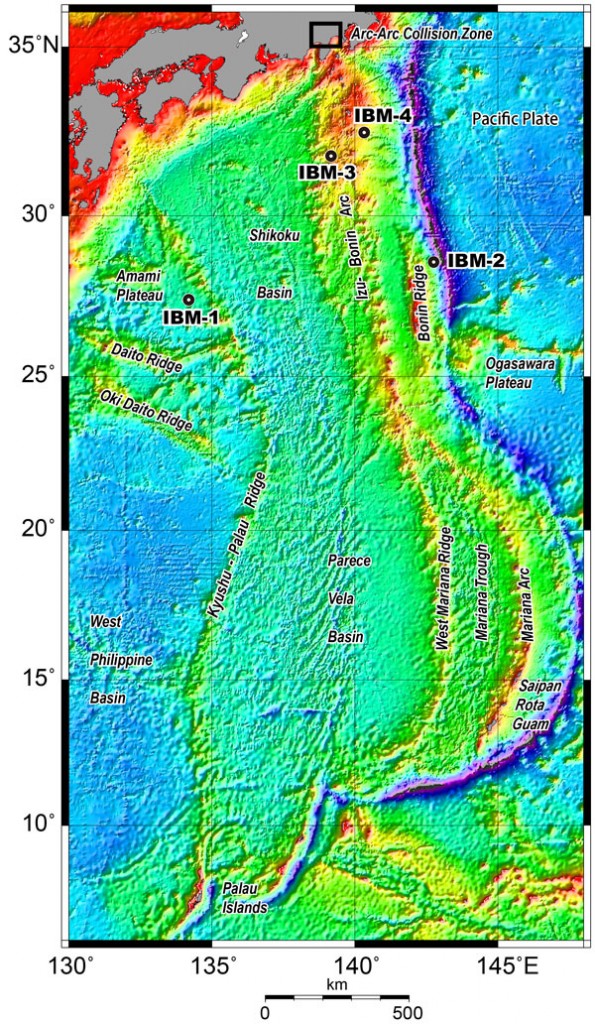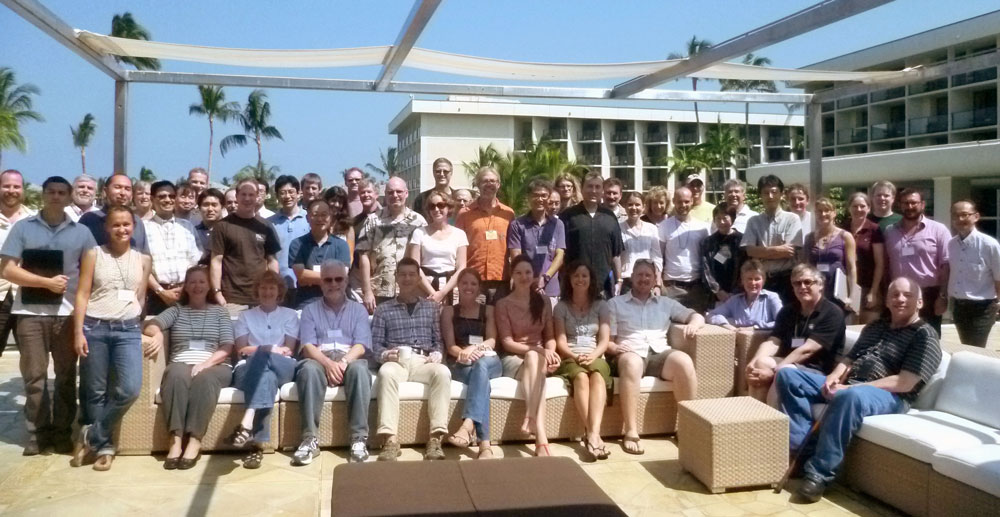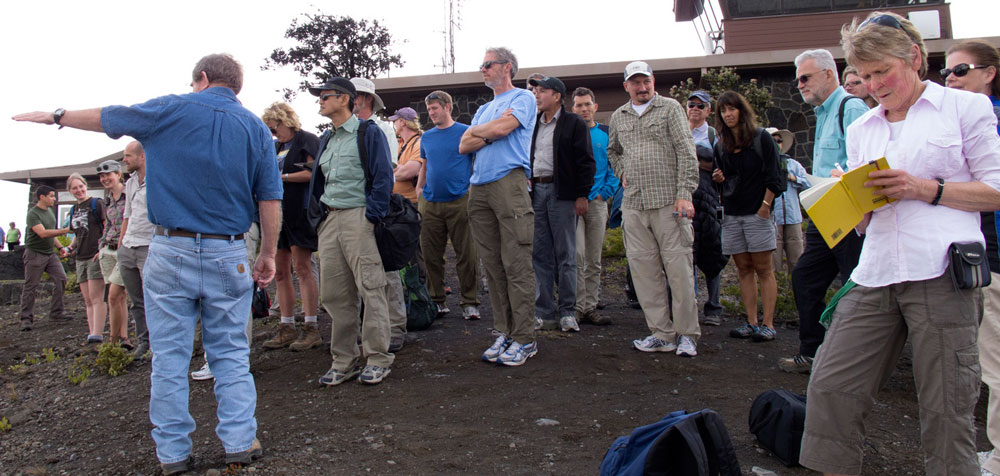Waikoloa, Hawaii, 18-21 September, 2012
1JAMSTEC, Japan; 2Western Washington University, USA; 3University of California, Santa Cruz, USA
Compiled by Susan DeBari, Philipp Ruprecht and Susanne Straub

Figure 1. Location map of the Philippine Sea Region. Numbers show proposed drilling sites IBM-1, IBM-2, IBM-3, and IBM-4.
A workshop was held September 18-21, 2012, in Kona, Hawaii, with the goal of soliciting international support for the endeavor of understanding continental crust formation in the Izu Bonin arc in the northwest Pacific ocean. Central to this project is riser-based deep drilling into the mid-crust of the Izu Bonin arc using D/V CHIKYU. The workshop was primarily sponsored by a Grant-in-Aid for Creative Scientific Research 19GS0211 to Y. Tatsumi and JAMSTEC. Additional funds to support attendance of U.S.-based scientists were obtained from the U.S. Scientific Support Program (through the Consortium for Ocean Leadership) and the GeoPRISMS Program.
The ~3000 km long intra-oceanic Izu Bonin-Mariana arc (IBM) has been long recognized as a primary site for understanding the formation of the continental crust (Fig. 1). A long history of past multidisciplinary exploration revealed the ubiquitous presence of a conspicuous low-Vp velocity (6.0-6.5 km/s) mid-crust layer that seismically resembles continental crust. This layer is common in arc crust, and, as such, is crucial in interpreting arc crustal structure globally. In the northern part of the IBM system (the Izu Bonin arc), the low-velocity mid-crust layer is within reach of ultra-deep riser-drilling and has been a dedicated target of the International Ocean Discovery Program (IODP). The IODP Science Plan for 2013-2023 “Illuminating Earth’s Past, Present, and Future” highlights the formation of continental crust as high-priority scientific Challenge 11 “How do subduction zones initiate, cycle volatiles, and generate continental crust?” as part of the main theme “Earth Connections: Deep Processes and Their Impact on Earth’s Surface Environment”.
Deep-drilling a single hole into the Izu Bonin arc is a major commitment in time and resources. Success is reliant on three companion riserless drilling expeditions in the arc by D/V JOIDES Resolution that are scheduled for 2014. These expeditions will provide crucial new data for the overarching goal of obtaining a complete temporal and spatial petrologic cross-section of Izu Bonin arc magmatism. These expeditions provide vital support for the planned CHIKYU drilling (IODP Proposal 698-Full3 at Site IBM-4) that will be discussed as a priority project at the CHIKYU+10 workshop on 21-23 April 2013 in Tokyo, Japan. This workshop will prioritize the future activities of the CHIKYU.
Overview
The workshop was attended by 58 participants (34 from US, 13 from Japan, 4 from UK, 2 from Switzerland, and 1 each from Mexico, Canada, Taiwan, New Zealand, Australia, Figure 2).

Figure 2. All participants at the conference venue, Waikoloa Beach Marriott, on the Big Island of Hawaii.
Attendees included a wide range of geophysicists, geologists, geochemists and petrologists whose research involves the genesis of arc crust. A primary goal of the workshop was to inform the broader geologic community about the goals of drilling in the Izu Bonin arc, as well as to solicit a very broad, international base of participation in proposed IODP expeditions, to rally support for the planned CHIKYU deep-drilling, and to obtain input on objectives and corollary studies.
The first day opened with background talks and discussions aimed at providing a framework for the proposed drilling. Talks focused on the physical and geochemical evolution of the Izu Bonin Mariana arc through time, the geophysical framework (including the enigmatic seismic properties of the middle crust and comparison to the Aleutian arc), and an overview of the goals of the three scheduled IODP drilling legs (subduction initiation, arc foundations, rifted rear arc).
The second day focused specifically on the CHIKYU deep drilling proposal and potential outcomes. This theme was supported by talks on the processes of crustal growth and evolution from exposed crustal sections and from thermal modeling.
The third day provided a break from talks in the conference room and allowed more informal discussions among participants during a field trip to observe the geology of the active Kilauea Volcano eruption (Figure 3).

Figure 3. Participants looking over at the summit caldera of Kilauea and the active eruption in Halema’uma’u crater during the field trip led by Don Swanson.
The forth and final day focused on specific scientific objectives for deep drilling in the Izu Bonin arc and what at-sea drilling strategies and shore-based studies would best support those objectives.
Workshop Program
The key question that motivates deep drilling in the Izu Bonin Mariana arc is how the middle crust evolves and how the processes of its growth relate to the growth of continental crust. Deep drilling in the IBM arc offers the opportunity to examine the critical relationships between magmatic processes and resulting geophysical structure. The linkages established here can also be used as a template to interpret active arc processes globally from geophysical surveys.
The workshop was structured around several key topics, and the key results are as follows:
More seismic surveys have been acquired over the IBM arc-back-arc system than any other island arc setting on Earth. Consequently, it is possible to contrast seismic velocity models across the arc representing different evolutionary histories, and to constrain them with strike lines where available. A multi-channel seismic reflection (MCS) survey was acquired in 2008 around the proposed drilling site of IBM-4 revealing a well-resolved domal basement high beneath the proposed drilling site. Comparison of MCS data with core recovered from ODP Site 792 indicates the section above the basement is comprised of Quaternary to upper Eocene volcaniclastic sediments. At the top of the basement high, andesitic lavas were sampled at 886 meters below seafloor (mbsf). A seismic refraction survey using densely deployed ocean bottom seismographs (OBSs) was also conducted along the MCS profile and clearly show a domal structure in the 6 km/s Vp iso-velocity contour. These Vp values, which are critical to identification of the middle crust, are located 3.5 km below sea floor at Site IBM-4, within reach of CHIKYU drilling.
The workshop presentations and discussions reinforced consensus that the Izu Bonin arc was the ideal place worldwide to study juvenile mid-crust formation, as there is minimal sediment recycling and minimal pre-existing continental crust. Hence, the net flux from the mantle/subduction zone to the crust is visible with the greatest possible clarity.
- What is the origin of the mid crust (test various hypotheses)
- Are intrusive and extrusive rocks genetically related (i.e., does the mid crust form in a distinct manner from the extrusive rocks)?
- Do all arc magmas stall at mid-crust levels before eruption?
- How fast do magmas ascend from mantle to crust?
- How are mafic magmas expressed within the crust – are they long-lived evolving bodies or rapidly solidifying small plutons?
Investigation of arc crustal sections exposed on land provide an important companion study for deep crustal drilling. The study of paleo-arcs provides a larger, more volumetrically abundant record of both the intrusive and extrusive record of the processes that generate continental crust from mantle-derived magmas. In turn, deep crustal drilling can answer many questions that remain unanswered after examination of exposed sections, the activity of which ended long before they were amassed in their current locations. For example, through the direct petrological, geochemical, and geophysical characterization of the crust at site IBM-4, a reference section of intraoceanic arc crust can be generated. The cored rocks and borehole properties can be directly linked to the seismic velocity structure of the crust, providing the first in situ test of seismic velocity models against known rock types and structures within the deep arc crust. The IBM-4 site will provide an essential reference both for active arc crust and for accreted arc crustal terranes.
(4) Other salient points related to drilling operations
- Temperature estimates for the proposed drilling depth of 5500 mbsf at IBM-4 do not exceed 170°C
- All coring cannot reasonably be obtained throughout the 5500 m drilling depth so borehole imaging technology will be critical. Drilling operations will also include sidewall coring (sampling from uncored intervals) and vertical seismic profiles.
- Costs for drilling with Chikyu will be on the order of $600,000 – $700,000 per day, with an estimate of roughly 9 months to reach 5500 mbsf. The total cost is thus as much as $200 million.
- What is the tempo of constructing arc juvenile continental crust?
- How does arc crust composition change with time?
- Is there older (pre-51 Ma) crust that makes up significant parts of the Izu arc?
- How do the results of ultradeep drilling into the Izu forearc fit with perspectives gained from other drill sites and from arc crustal sections?
- What is the relationship and proportion between volcanic and plutonic rocks in ultradeep juvenile arc crust?
- What was the role of fluids in the evolution of the rocks that we will penetrate?
- What is the nature of the ultradeep biosphere?
- What can we learn about convergent margin mineralization by ultradeep drilling into arc crust?
- What is the paleomagnetic record preserved in Izu arc crust?
- How well can we use surface geophysical measurements such as heat flow and seismic velocity to infer properties at depth?
Given the distinct core recovery rate in riser-drilling platforms (i.e. targeted sampling) compared to riserless drilling (i.e. almost continuously coring possible) the workshop discussions also revolved extensively around how to prioritize sample recovery strategies. Workshop participants made recommendations for prioritizing sample recovery, in particular around transitional zones derived from geophysics as well as extensive coring at the base of the drillhole. Further discussion is likely to occur at Chikyu+10.
For a more detailed report on the workshop see http://www.jamstec.go.jp/ud2012/
Roadmap to Future scientific drilling in the Izu Bonin arc
In 2014 three-riserless expeditions with JOIDES Resolution are scheduled in three sites (IBM-1, IBM-2, IBM-3) of the Izu-Bonin Arc. A call to participate in these expeditions has been made with application deadlines of May 1, 2013. The three legs (each about two month duration starting in April 2014) are designed to address key questions of crust generation and modification. The expeditions will be kicked off at site IBM-3 in the rear Izu arc to generate data on the missing half of the subduction factory, as most drilling efforts have focused on the IBM forearc. This leg will document across-arc variation in magma composition from Eocene to Neogene time to test models of mantle flow, intra-crustal differentiation, and magma generation during the arc evolution. The following two months are scheduled to drill into a section of pre-arc oceanic basement at site IBM-1 (695-Full2). This site is located beneath the 1-1.5 km of sediments in the Amami Sankaku Basin west of the Kyushu-Palau Ridge remnant arc. Such basement may make up an important part of the lower-arc crust, and contribute to arc magma chemistry through assimilation and partial melting. The 2014 drilling campaign in the Izu-Bonin arc will finish at Site IMB-2, close to the Bonin Ridge (696-Full3). The goal at this site is to unravel subduction initiation and test the supra-subduction zone ophiolite model.
Although each of the three scheduled JOIDES Resolution expeditions stand on their own merits, they will also deliver crucial complementary data for the ambitious ultra-deep drilling proposal (IBM-4; 698-Full3). The ultra-deep drilling project itself would provide first-ever in-situ unaltered samples from the region in the arc crust where crustal differentiation and evolution is most dramatic. The “transferability” of a direct view of the nature of the middle crust in the Izu-Bonin arc with crustal studies from exhumed sections has the potential of being mutually transformative. Ground-truthing potential exists for a large variety of techniques. How do seismic velocities and densities vary locally in the borehole and how are those parameters recovered from surface observations? How accurate are surface heat flow measurements in projecting the thermal evolution in the borehole? In addition, deep drilling provides tremendous opportunities to obtain new insights on fluid compositions and distribution in the crust, the presence of a deep biosphere, and the potential for observing in-situ mineralization processes.
The new data from all these drilling expeditions will provide for innovative cross-disciplinary research through the integration of many subdisciplines and multinational specialists. The extraordinary collaborative effort made at sea will culminate in extensive post-cruise shore-based studies (e.g., isotope geochemistry, thermo- and geochronology, geophysical experiments with core samples) that are set to transform our understanding how juvenile arc crust forms and differentiates with time.
Reference informationGeoPRISMS Newsletter, Issue No. 30, Spring 2013. Retrieved from http://geoprisms.nineplanetsllc.com
